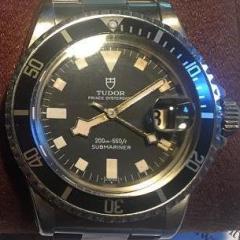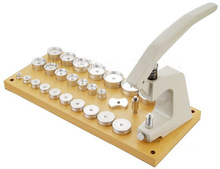Leaderboard
Popular Content
Showing content with the highest reputation on 05/02/18 in all areas
-
Well when I said old tool, here's a internet copy of a 1899 watchmakers suppliers catalogue similar tools appear on page 102 of the catalogue they may have at the time forgot to add your name to there mailing list . https://archive.org/details/20thcenturycatal00purd It does make interesting reading as a catalogue thats over 100 years old there are some very familiar old tools listed.2 points
-
Its an old tool used for cutting jewel holes in plates or widening existing holes to take a new jewel, the plate is used to set the tool to cut a hole at a given size,2 points
-
Good advice there. Generally, these are designed to come apart one way only, to keep us out of trouble. But, as you have found, there is always a way around things... The dial side gears can easily fall out of position while you are tinkering on the back side. Then get tweaked. You really should pull the balance cock as advised, set it safely aside (it's going to need cleaning and proper lubrication anyway), flip the movement and pull the date plate and associated parts, the hour wheel, minute wheel, canon pinion etc. on the top side, so that all can be cleaned. (keyless too!) Then flip it back and take the going train bridge, which are those screws you indicated earlier. Admittedly, I watched a few videos, and took some on-line courses, but at that time I had already torn down several movements too (but not Rolex ones!) and I can say the combination of book/video instruction as well as hands-on is how some one like me gets it. I have destroyed hairsprings. And they were early 2784 movements (for Tudor) and I had a hell-of-a-time finding the correct parts to get it right- I learned they offered two different beat rate 2784's but that's another story... So, I guess I'm saying: I'm not trying to discourage you, but if you don't follow the advice by those (with WAY more experience than me) you are going to be spending a great deal more in parts because parts for Rolex movements are easily 5-10 times the cost of Eta parts. This coming from someone not too much further down the road than you are today...1 point
-
1 point
-
Regarding the acrylic crystal, not necessarily, but even so this is not the type of watch that probably came with an acrylic. Seiko usually does mineral glass, not acrylic, like the vintage Swiss watches. Most of the watches that I've encountered have had a gasket as well and yes your bezel should have space for one but, I guess, since yours didn't come with one maybe they really didn't use a gasket after all. To go for the original look I'd just get a standard cousins mineral glass. I don't know if there's a difference between the sternkreuz and the cheaper one. The cheaper one seems to look like the one that you have.1 point
-
First of all, "dial feet screws" aren't really screws, but eccentrics permanently attached to the plate by riveting. Getting 3 out of a box of100 would be actually a good result, but you can buy 1,000 generic screws and none will do. That being said, with Miyota more than other makers, parts are simply unavailable. Either work-out a ingenious solution, or buy a new mov.t. BTW, we have a sections here used to introduce oneself even before asking questions.1 point
-
1 point
-
Do you know a friendly watchmaker with a Big Bertha? That’d be the way to go if at all possible. They really are stupendously good. Sent from my iPhone using Tapatalk1 point
-
I don't know about sapphire but the mineral glass on cousins looks like yours at first glance. Are you sure that this is the original glass of the watch ? Usually glasses nowadays (glass glasses not acrylic) are held in place by a plastic gasket. Either it might not be the original glass for it and, maybe, it used an acrylic either you'll need a plastic gasket as well.1 point
-
Skit indeed. With parts for this calibre (whether Zodiac or AS base) being practically impossible to find I think I'd be getting out the silver solder and a fine file ... or trying to find a barrel of the same dimensions from another calibre, AS or other, and living with not having a sealed-for-life barrel! I don't know if anyone else knows where to source this part from; I've looked at all the usual suspects and come up blank...1 point
-
Any new tool I get I always inspect it very closely, and almost always take it to the buffing wheel and polish it up. It does not eliminate the chance of scratching, but certainly reduces it. Screwdrivers I inspect but never polish. Maybe touch-up if the end doesn't look perfect.1 point
-
1 point
-
I think the interesting bits from the article for your situation are: i) The mainspring barrel specifically has "do not open" on it; a barrel complete is intended ii) An attempt at replacing the mainspring could be made but "the edges (where the cap and barrel were crimped together) are too thin and weak and usually just warp when trying to reseal the two." iii) Various mainspring sizes are quoted and the author of the aforementioned article has witnessed different sized mainsprings when working on these watches. The spring sizes quoted vary as: 1.25 X .11 X 10", 1.10 X .11 X 10", 1.20 X .13 X 12" and 1.20 X .13 X 12.5".1 point
-
Great! I will get my battery in as fast admin possible and give you a headset up with the sizes. Are those pictures adequate? Or would you like other. Thanks, Luca M1 point
-
1 point
-
Hi Mark, You have plenty to practice on there. Start with the pocket watches. See Mark Lovick on u tube, he runs courses. I consider de Carles book Practical Watch Repairing an asset and have referred to it for years. There are many experienced and helpful people on this excellent forum. All good wishes, Mike.1 point
-
The top silver coloured part looks to be a collet for a lathe.1 point
-
Welcome! pocket watches are a great way to start as everything is a bit larger. Of course, I don’t heed my own advice but there are a lot of other folks here with tons of knowledge and experience to draw from.1 point
-
1 point
-
This looks typical of some watches of that era which I have just serviced. The case-back looks like a press fit which can be removed with a case knife in the normal manner. The dial look much larger than the resultant opening in the case-back and so the movement will almost certainly be removed from the front. This will require removal of the bezel (with crystal intact normally) by using a fine blade at the join with the case to ease the bezel off until it comes free, or a case knife can then be used. The movement will likely be fixed to the case by a couple of case screws which are accessed from the case-back. The stem is removed in the normal way by loosening screw or pressing spring to release stem.1 point







.jpg.6225a64433578a11e0218b27c20b13f5.thumb.jpg.d82b0cd1e370f3a3a59a06afa957d184.jpg)
.jpeg.5ce1ab90a52cf4a2194e9f7b41ef2759.jpeg)